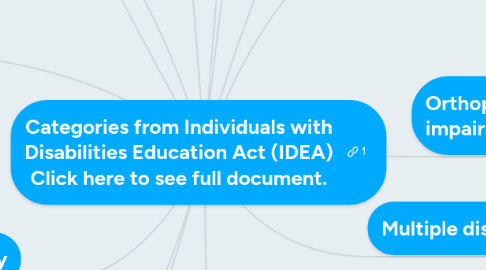
1. Deafness
1.1. ...means a hearing impairment so severe that a child is impaired in processing linguistic information through hearing, with or without amplification, that adversely affects a child's educational performance (NICHCY, p. 3).
1.1.1. ACCOMMODATIONS may include gaining child's attention prior to speaking and TV captions. Click here to learn more.
2. Hearing impairment
2.1. ...means an impairment in hearing, whether permanent or fluctuating, that adversely affects a child’s educational performance but is not included under the definition of “deafness.” (NICHCY, p. 3)
2.1.1. ACCOMMODATIONS may include sign language interpretation and providing extended time on exams. Click here to learn more.
3. Intellectual disability
3.1. ...means significantly subaverage general intellectual functioning, existing concurrently [at the same time] with deficits in adaptive behavior and manifested during the developmental period, that adversely affects a child’s educational performance (NICHCY, p. 3).
3.1.1. ACCOMMODATIONS may include listening instead of reading text, test in a small group setting, and allow dictated responses. Click here to learn more.
3.1.1.1. CASE STUDY: Click here to view.
4. Other health impairment
4.1. ...limited alertness with respect to the educational environment (NICHCY,p. 4).
4.1.1. (a) is due to chronic or acute health problems such as asthma, attention deficit disorder or attention deficit hyperactivity disorder, diabetes, epilepsy, a heart condition, hemophilia, lead poisoning, leukemia, nephritis, rheumatic fever, sickle cell anemia, and Tourette syndrome; and
4.1.2. (b) adversely affects a child’s educational performance.
4.1.2.1. ACCOMMODATIONS may begin with an IEP. Click here to learn more.
5. Speech or language impairment
5.1. ...such as stuttering, impaired articulation, a language impairment, or a voice impairment that adversely affects a child’s educational performance (NICHCY, p. 4)
5.1.1. ACCOMMODATIONS may include working in student teams, communicating pictorially, and send material home to preview. Click here to learn more.
6. Deaf-blindness
6.1. ...means concomitant [simultaneous] hearing and visual impairments, the combination of which causes such severe communication and other developmental and educational needs that they cannot be accommodated in special education programs solely for children with deafness or children with blindness (NICHCY, p. 3).
6.1.1. ACCOMMODATIONS may include note takers, tutors, and readers. Click here to learn more.
7. Developmental delays
7.1. Particularly under age 3: delays in cognitive, physical, communication, social or emotional; and adaptive development.
7.1.1. ACCOMMODATIONS may include maintaining structures for social interaction, and posting clear and predictable schedules. Click here to learn more.
8. Emotional disturbance
8.1. ...means a condition exhibiting one or more of the following characteristics over a long period of time and to a marked degree that adversely affects a child’s educational performance (NICHCY, p. 4):
8.1.1. (a) An inability to learn that cannot be explained by intellectual, sensory, or health factors.
8.1.2. (b) An inability to build or maintain satisfactory interpersonal relationships with peers and teachers.
8.1.3. (c) Inappropriate types of behavior or feelings under normal circumstances.
8.1.4. (d) A general pervasive mood of unhappiness or depression.
8.1.5. (e) A tendency to develop physical symptoms or fears associated with personal or school problems.
8.1.6. The term includes schizophrenia. The term does not apply to children who are socially maladjusted, unless it is determined that they have an emotional disturbance.
8.1.6.1. INTERVENTIONS may include an IEP, encouraging organization and recognizing accomplishments. ACCOMMODATIONS may include allowing more time to complete tasks. Click here to learn more.
8.1.6.1.1. CASE STUDY - Click here to view.
9. Multiple disability
9.1. ...means concomitant [simultaneous] impairments (such as intellectual disability-blindness, intellectual disability-orthopedic impairment), the combination of which causes such severe educational needs that they cannot be accommodated in special education programs solely for one of the impairments. The term does not include deaf-blindness (NICHCY, p. 4).
9.1.1. ACCOMMODATIONS may include allowing student to record lessons and give more time to complete assignments. Click here to learn more.
10. Orthopedic impairment
10.1. The term includes impairments caused by a congenital anomaly, impairments caused by disease (e.g., poliomyelitis, bone tuberculosis), and impairments from other causes (e.g., cerebral palsy, amputations, and fractures or burns that cause contractures) (NICHCY, p. 4).
10.1.1. ACCOMMODATIONS may include devices to access information, and those to assist positioning and mobility. Click here to learn more.
11. Specific learning disability
11.1. impairment of understanding or use of language, including imperfect ability to listen, think, speak, read, write, spell, or to do mathematical calculations (NICHCY, p. 4)
11.1.1. ACCOMMODATIONS include input from supporting individuals, such as parents, teachers and administrators. Click here to learn more.
12. Traumatic brain injury
12.1. ...impairment can include cognition; language; memory; attention; reasoning; abstract thinking; judgment; problemsolving; sensory, perceptual, and motor abilities; psychosocial behavior; physical functions; information processing; and speech (NICHCY, p. 4).
12.2. ...caused by an external physical force, resulting in total or partial functional disability or psychosocial impairment, or both, that adversely affects a child's educational performance (NICHCY, p. 4).
12.2.1. ACCOMMODATIONS may include "homebound instruction, gradual increase in school attendance, or change in class schedules to a less demanding course load" Click here to learn more.
13. Autism
13.1. ...means a developmental disability significantly affecting verbal and nonverbal communication and social interaction, generally evident before age three, that adversely affects a child’s educational performance (NICHCY, p. 3).
13.2. Other characteristics often associated with autism are engaging in repetitive activities and stereotyped movements, resistance to environmental change or change in daily routines, and unusual responses to sensory experiences (NICHCY, p. 3).
13.2.1. ACCOMMODATIONS may include consistent routines and visual aids. Click here to learn more.
14. Visual impairment (including blindness)
14.1. ...education affected by vision, partial or complete blindness (NICHCY, p. 4)
14.1.1. ACCOMMODATIONS may include seating close to front of the classroom, verbalizing works written on the board, and sitting with a partner. Click here to learn more.
